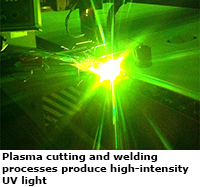‘Exposure to UV light’ regulations not being applied
08/07/2014
Four years after the introduction of the EU regulations on exposure to UV light, many companies and industry sectors are still not aware of their statutory obligations under the legislation. That is the experience of UV Light Technology Limited, whose area of expertise includes on-site surveys to measure UV light exposure levels and the provision of training courses on workplace risk management and hazard awareness. The Control of Artificial Optical Radiation at Work Regulations 2010 brought into UK law the Artificial Optical Radiation 2006/25/EC Directive. This imposes legal duties on employers to protect workers who may be at risk from artificial UV light exposure.
The Control of Artificial Optical Radiation at Work Regulations 2010 brought into UK law the Artificial Optical Radiation 2006/25/EC Directive. This imposes legal duties on employers to protect workers who may be at risk from artificial UV light exposure.UV Light Technology’s Managing Director, Paul Jackson, said: “Of course, most companies recognise that the use of UV light in the workplace impacts on operators and will take steps to meet health and safety requirements. However, our experience shows that there is a lack of awareness and a great deal of misunderstanding about the new regulations and the stringent, statutory exposure limits specified.”
Typically, UV light exposure risks can occur with the curing of UV paints, adhesives and coatings, NDT fluorescent inspection processes for crack detection, UV light disinfection of industrial processing fluids for killing bacteria and the unintended by-product of metal fabrication, such as welding and plasma cutting.
In the case of welding, for example, the effects are not only on the operator, who will undoubtedly have personal protective equipment, but also employees in the vicinity. Employees walking by a welding station up to several metres away can exceed in seconds the legal level of personal UV light exposure.
Employee UV light exposure levels are a function of the UV light spectral output of the equipment, the UV light irradiance level (for example the distance of employees from the light source) and exposure time. By taking measurements for each piece of equipment in its particular application, the maximum permissible personal exposure time can be calculated. It has to be borne in mind that exposure is cumulative and limits cannot be exceeded within an eight-hour period per day.
Paul Jackson continued: “The headline UV light exposure limits in the Directive for broadband sources state 30 J/m² eff for the skin and eyes exposed to UV light in the wavelength region 180-400 nm and 10,000 J/m² for eyes exposed to wavelengths of 315-400 nm. Depending on the UV light source, one or both limits may apply. It is a regulatory offence for workers to exceed these exposure limits.
“However, the key difficulties for most companies are understanding which exposure limit is applicable for the eyes, assessing correctly the levels of exposure and, therefore, the risks. This is why we offer one-day training courses designed specifically to help employers meet their legal obligations for a safe workplace and working environment. We run similar courses for employees to raise their levels of hazard awareness.”
In addition to the courses, UV Light Technology Limited has published its own technical guide: ’Safety First with UV Light’, a practical guide to risk assessment and control of personal UV light exposure from non-coherent artificial sources in the workplace.
www.uv-light.co.uk